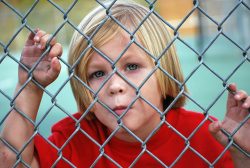Childhood Disintegrative Disorder
Commonly known as the Heller’s syndrome and Disintegrative Psychosis, Childhood Disintegrative Disorder or CDD is a rather rare condition today, the manifestations of which are generally seen after three years of age. It is characterized by delays of language development, motor skill functioning as well as social function. The etiology or cause of disintegrative psychosis is still unknown despite many researches.
There are various similarities between Childhood Disintegrative Disorder and Autism, and may sometimes even be characterized as a minor version of the disease. One of the major differences however is the fact that the pattern of onset of the symptoms of CDD follows a period of normal and unobstructed growth and development, and later a marked regression of skills. In many cases, by the time a confirmed diagnosis of the disease is made, the child may already be experiencing the different forms of developmental delays that are associated with it. There is no specific age during which the disease presents its symptom, but it can occur at any age between 2 and 10 years. The definition and confirmation of the disease is largely based on opinion and may therefore vary.
Onset
The developmental regression can be very abrupt in onset in certain cases and the child may try to describe this to parents and guardians, which may not be expected. It has been observed that the description of some children is the reaction to some form of hallucination. In reality however, the reaction of the child is based on the fact that he or she might be losing some of the skills which were naturally attained initially. This therefore causes extreme confusion and a feeling of devastation which has adverse affects on the child, as well as the family. Because the true cause of the disease remains unknown there is still a great deal of controversy regarding the correct treatment of the condition.
The condition in short, is characterized by the normal growth and development of a child till the third or fourth year of life, following which there is a marked degeneration of skills which may be motor or social, physical as well as vocal. The child may lose language ability as well as many other skills that earlier either developed naturally, or were learned. The disorder is recognized by the DSM-IV as well[2].
Causes, Incidence and Risk Factors
There is no known cause of Childhood Disintegrative Disorder, but there are a number of problems associated to the functioning of the brain as well as the nervous system, which may have a significant role to play in the development of the condition. A child with Childhood Disintegrative Disorder tends to lose the following:
- The ability to communicate properly because of the loss of verbal and language skills
- Nonverbal actions and behavior
- Previously learned skills
Signs

A loss in social skills is a symptom of CDD.
Following normal development till 3 or 4 years of age, a child diagnosed with Childhood Disintegrative Disorder loses various skills which were either taught, or which developed naturally. These may include verbal, social, motor and communication skills.
There are six main areas that have been chalked out, which are most affected by the condition; these have been enlisted as follows:
- The ability to effectively express feelings, communicate a message across or produce speech
- The ability to understand, comprehend and even listen to what is being said
- Self care awareness as well as social skills
- Bladder and bowel control
- Motor skills
- Playing skills
There is a marked lack of functionality and impairment which may occur in two of the three enlisted criteria:
- Interest patterns as well as repetitive behaviors
- Communication skills and mode
- Social interactions and skills
The outlook of children suffering from this condition is usually not good. Children suffering from this disorder tend to develop similar symptoms of those suffering from severe autism by the age 10.
Symptoms
- Lack or delay in spoken language
- Impairment in non-verbal behavior
- Inability to initiate or maintain conversations
- Lack of playing activity
- Loss of bladder and bowel control
- Loss of communication skills or language ability
- Motor skills are lost
- Social skills are lost
- Problems in forming any relationships with children and other family members
Diagnosis
Usually heath care providers determine if the child is suffering from this disorder or another childhood condition such as childhood schizophrenia or even autism. The most distinctive sign of this disorder is the loss of the normal developmental milestones that children normally have. The diagnosis is confirmed if the child has lost functions in two distinct areas of development.
Treatments
The condition is treated in a manner similar to that of autism. The disorders have many similarities and in the proposed revision of DSM-5 the condition may be characterized in Autistic Spectrum Disorders. Experimental treatments have used steroid medication to slow down the progress of the condition. There is no effective cure of the condition and usually the affected children require lifelong care. A combination of medication and behavior therapy are used to treat the condition[3].
Behavior Therapy
The aim of this therapy is to help the child re-learn language, social skills and self care. The therapy uses a reward system to encourage the child to learn desirable behavior and discourage behavior which is problem causing. Parents, care givers and teachers are also using this form of therapy to get better results.
Medication
As such there are no medicines that are available to treat the condition. Anti-psychotic medications are sometimes required to treat extreme behavior problems. If seizures are present, anticonvulsant medicines are used.
References:
http://www.ncbi.nlm.nih.gov/pubmedhealth/PMH0002502/
DSM-IV The Diagnostic and Statistical Manual of Mental Disorders, Fourth Edition
http://www.mayoclinic.com/health/childhood-disintegrative-disorder/DS00801





